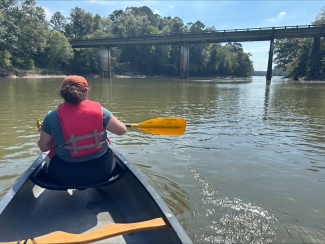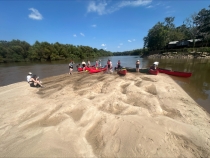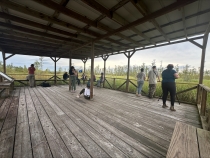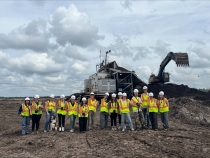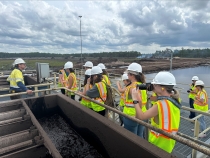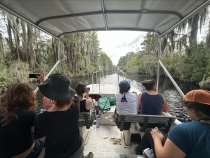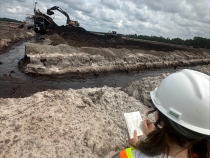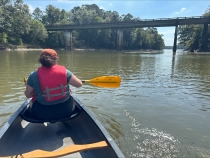Mines in Southeast Georgia can conjure many images — swamps, pits, pines, machinery. A band of artists may not be at the top of this list. Nevertheless, University of Georgia Professor of Art Michael Marshall and 14 students were invited to don hardhats and visit the Chemours Mission Mine in the Altamaha River Basin this past September to contemplate the setting through different eyes and tell a greater story of this region.
Marshall, a professor of photography and director of the Social Ecology Studio at the Lamar Dodd School of Art, led students pursuing creative and design degrees to conduct arts fieldwork and research through seemingly contradictory landscapes: a titanium mine and the Okefenokee Swamp. In a two-day excursion called “Art in the Field,” students explored the messy world of mines and swamps, fully supported by the Vibrant Communities initiative of the Chemours Mining Company. The grant creates an opportunity for cultural interpretation and study of the Lower Coastal Plains of southeast Georgia.
“I went in with preconceived notions of mining — its destruction of the landscape. It is so much more complicated than that,” said Marshall. He and the fall cohort of students were surprised to discover a complex conservation effort at the Chemours Mine involving survey tools, photography, scanning, and land reclamation techniques to methodically restore altered landscapes. Side-by-side, visitors to the mine can compare a site being actively excavated with a pine forest that has been fully restored after five years of effort involving a host of experts, including UGA ecologists and geologists. This restoration process is arduous, from temporarily relocating wildlife and carefully preserving the microorganisms and seeds of the topsoil to reestablishing the native biome and initiating plant regrowth.
On the very same day that students visited the mine they toured the Okefenokee Swamp by boat, photographing Spanish moss, water lilies, and pitcher plants along the shore, discussing the ecological connection between water and mineral deposit resources across lands pristine and disturbed. Walking along a trail, an eager photography student rushed to set up a large format camera, inspiring the curiosity of peers whose arts practices differ considerably. In contrast, a scientific illustration student needed more time to sit quietly beside a specimen and faithfully render its parts. These two artists are not unlike a geologist surveying the land or a biologist documenting the ecosystem, yet their aims diverge.
“I grew up around a lot of nature — camping, hiking — and always found that I feel most like myself outside,” said MFA student Harper Nichols. “This upbringing has influenced a lot of the work I'm making, whether that is landscape photography, or going on hikes to find materials to include in cyanotypes. Art in the Field gave me the opportunity to participate in something that felt so much like the way I grew up and first got interested in art. It really pushed me as an artist to say, ‘what is the story we are telling here’ and how does that story then get told visually!”
The variations in the landscape are reflected in the different approaches these students of ceramics, landscape architecture, and other diverse media take in their creative interpretations of it.
With one-half of the excursion completed (unfortunately cut short by the trajectory of Hurricane Helene), Marshall looks forward to taking a second group out in spring of 2025 to produce work for a group exhibition and panel discussion in April at the Lamar Dodd School of Art’s Dodd Galleries centered on the environment, contemporary culture, and the arts. He anticipates a range of work inspired by the unexpected exchanges of not only swamp and mine, but also of our relationship to these precious materials and their products.
“It was exciting to observe the students’ transformative recognition of an environmentally oriented company like Chemours and the efforts it goes through to make the mining processes sustainable. It challenges us — or, at least me — to reevaluate our relationship to natural resources and their extraction. I use objects with these minerals all the time. I am part of this process.”
Image: student kayaks in Southeast Georgia. (photo by Michael Marshall)

